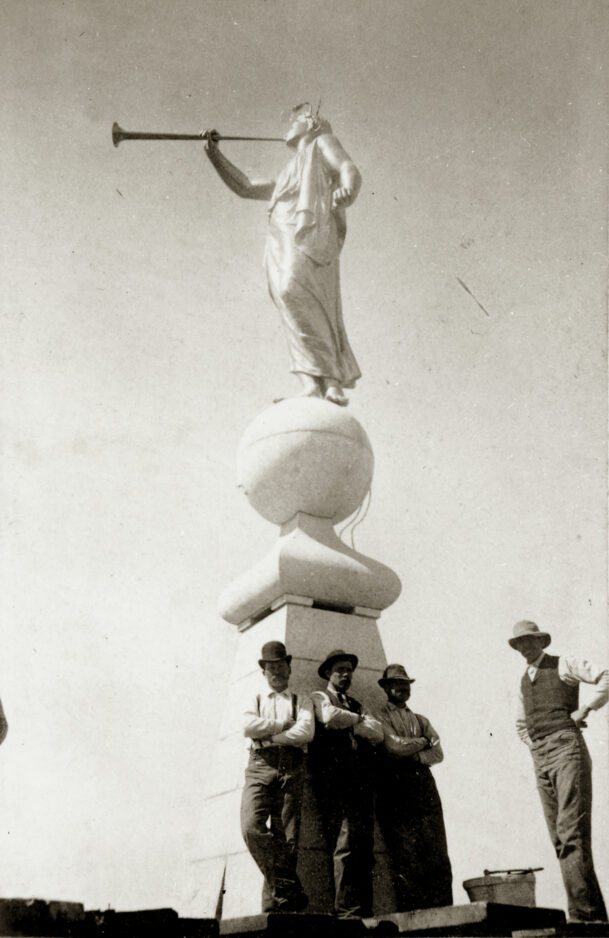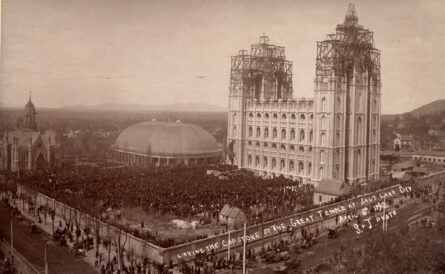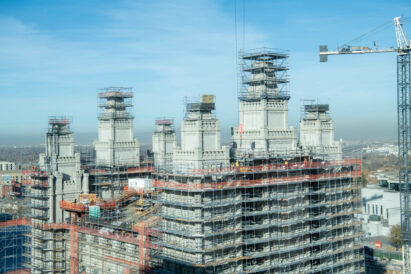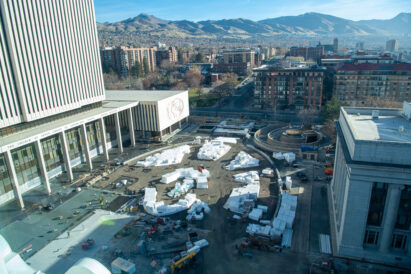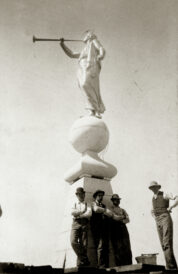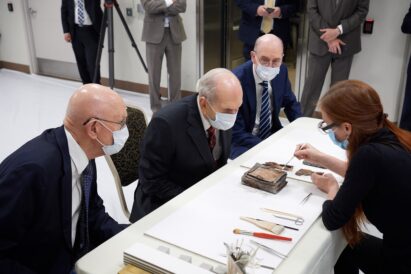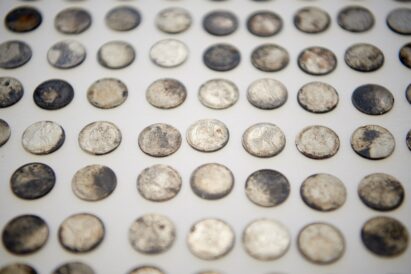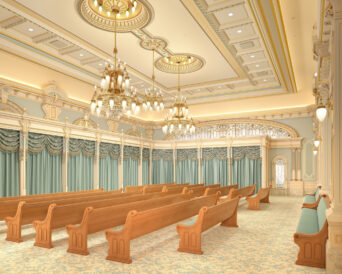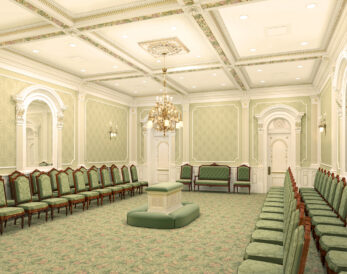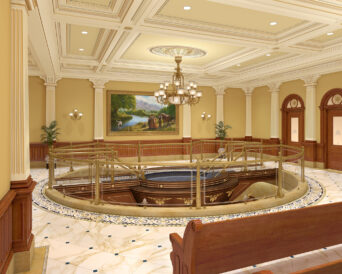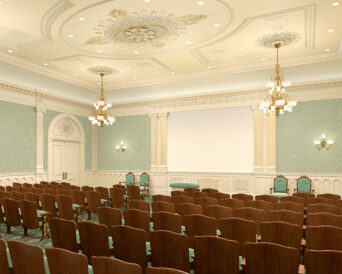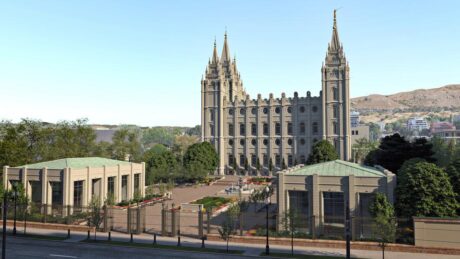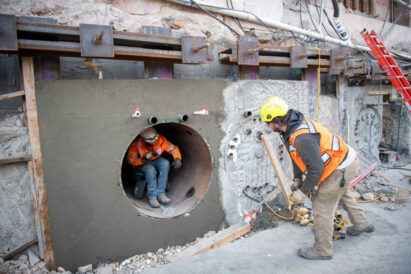Iconic Salt Lake Temple renovation to bring new look to Temple Square
- A rendering of the new Temple Square from the south side.
- A photo of April 6, 1892, when the church put the capstone in place.
- The Salt Lake Temple is surrounded by scaffolding during renovation.
- Construction continues on the plaza by the Church Office Building.
- 2021 construction on the plaza adjacent to the Church Office Building.
- Crew members stand by the capstone and newly placed Angel Moroni on the Salt Lake Temple, circa 1892.
- Work Crews, historians and media look on as the Salt Lake Temple capstone is cut open to reveal items from a time capsule dating to 1892.
- The First Presidency of The Church of Jesus Christ of Latter-day Saints, President Dallin H. Oaks, President Russell M. Nelson, middle, and President Henry B. Eyring, are shown items from the capstone time capsule.
- Coins found in the capstone of the Salt Lake Temple.
- A rendering of the veil room in the newly renovated Salt Lake Temple.
- A rendering of the Celestial Room in the Salt Lake Temple following renovation.
- A rendering of one of the new sealing rooms in the Salt Lake Temple.
- A rendering of the second baptistry being added to the Salt Lake Temple.
- A rendering of one of the many rooms in the Salt Lake Temple.
- A rendering of the new Temple Square.
- Crew members move large pipes through the seismic strengthening process under the existing footings of the Salt Lake Temple during the Temple Square renovation project in December 2021.
The iconic Salt Lake Temple of The Church of Jesus Christ of Latter-day Saints has been a symbol of the church worldwide since the 1890s. Its Gothic spires and symbolic carvings add to its grandeur.
The days are long gone since the temple stood out among buildings in downtown Salt Lake City. Yet, over the years, it continues to attract millions to its grounds and gardens known as Temple Square — home of the world-renowned Tabernacle Choir and Orchestra.
Temple’s history
According to church history, “Within days of the arrival of the first company of Latter-day Saint pioneers in July 1847, their leader, Brigham Young, waved his hand over a spot of hard, dry ground. He announced that at that precise location they would build a temple, their most sacred place of worship.”
Church leaders designated the 10-acre plot of ground as Temple Square, instructing surveyors to lay out the city on a grid pattern that would be square with the compass and place the temple literally at the heart of the city. They named streets according to their distance and direction from Temple Square — 600 South is six blocks south of Temple Square, 300 West is three blocks to the west.
“More than just a matter of functional design or conceptual convenience, the temple was central to the faith of the pioneers who settled the Salt Lake Valley. Unlike Latter-day Saint meetinghouses, where anyone may attend Sunday services and other meetings, temples are open only to faithful Church members for the performance of their highest, most sacred rites,” according to church information.
“Building the temple was a long and laborious process. With the painful experience of Nauvoo still fresh in their minds, Church leaders determined that the Salt Lake Temple would be almost fortress-like in its design and construction. They discovered a deposit of granite 20 miles southeast of Temple Square in Little Cottonwood Canyon–now the home of the Alta and Snowbird ski resorts,” church history states.
Workers painstakingly chiseled out of the canyon walls huge granite blocks that weighed from 2,500 to 5,600 pounds each and carefully transported them to Temple Square, first by ox-drawn wagon and later by railroad. There, expert stone cutters carved the blocks to fit perfectly into place.
Skilled workers used craftsmanship and artistry on temple interiors, where they applied their best expertise to draperies, furnishings, tapestries and floors in the building’s more than 170 rooms.
What is quite remarkable is it took 40 years to complete the temple.
It was finally finished and dedicated in 1893. There were 31 dedicatory sessions held between April 6-24 that year. While Brigham Young watched its construction, he did not live to see its completion.
“Most of the work was donated labor as pioneer men and women took time off from the backbreaking work of establishing their ‘Zion’ to contribute their time, skills and materials to the temple project,” according to the church.
Brigham Young called upon many skilled artisans who had joined the church during its early days. These new members had brought their tools and techniques with them as they relocated to Utah from England, Wales, Scotland, Scandinavia and the eastern United States.
Young’s own brother-in-law, Truman O. Angell, was the lead architect on the temple.
Although church leaders and members wanted the temple to be the finest they could erect, it was a time of frugality for the Latter-day Saint community. At one point, two or more tiers of blocks had to be taken down and replaced because the workers were using chips of granite between the blocks in order to minimize the use of expensive mortar.
“Build not for today nor tomorrow,” Brigham Young counseled the workers, “but for all eternity.”
Through many trials and setbacks, that is what the saints did. While the temple has served well over a century, it would not last through the millennium or even a major earthquake in its current condition.
Temple renovation
During the April 2019 Annual General Conference of the church, President Russell M. Nelson announced plans for the renovation of the temple. On Dec. 31 of that year, the temple was closed for a major four-year renovation. The renovation would bring the foundation and building up to seismic codes as well as shoring up the foundation and walls, fixing loose blocks of granite and making it a building to potentially last through the millennium as Brigham Young hoped.
It wasn’t just the temple itself but the majority of Temple Square, including the North Visitor’s Center and the plaza at the Church Office Building, that would be completely updated, renovated and restored.
As the temple began to be worked on, it was remembered that a time capsule had been place in one of the granite balls on top of a spire. It was time for Nelson and his counselors in the First Presidency, Presidents Dallin H. Oaks and Henry B. Eyring, to take a peek and see just what was hidden in 1892.
The capstone
Church historians recorded the auspicious occasion.
“The laying of the Salt Lake Temple capstone was a seminal event in the history of The Church of Jesus Christ of Latter-day Saints. One newspaper account describes ‘the crush, the enthusiasm, and the widespread interest’ occurring on Temple Square on April 6, 1892,” the church notes.
“A crowd of 30,000 people gathered around the temple, with another 10,000 looking on from nearby streets, building roofs and trees. They were there to see the finishing piece placed atop this sacred worship space that had been under construction for 39 years. Even the early spring weather was wonderful. ‘Nothing more peaceful and beautiful could have been desired or prayed for than the day which was to see the consummation of so momentous an event,’ the article says.”
A journalist atop the temple to witness the laying of the capstone, including the deposit of a time capsule within it containing books, photos, letters, paper notes, medallions and coins (one of his own included), mused “on when, how, and under whose eyes it would be exhumed in some untold age in the future.”
Fast forward 128 years to May 18, 2020, a day perhaps equal in balminess but not in fanfare. No large crowds were present. A few dozen construction workers removed that same 3,800-pound circular granite capstone, along with its time capsule contents and the angel Moroni statue that has stood on top of it. This was done for preservation and refurbishing during the temple’s seismic upgrade that began in January 2020, the church reported.
“It makes me laugh a little bit (to think about that journalist and the large cultural event surrounding the laying of the capstone),” said Emily Utt, historic sites curator with the Church History Department. “Our opening (of the capstone) has been a few people on a loading dock with very small chisels. I don’t know if (the people of 1892) could have imagined that kind of interaction. They had such fanfare. Our opening has been much quieter.”
Two days after the capstone’s removal from the temple, the First Presidency joined a small group in the loading dock of the Church History Library to witness the initial opening of the time capsule. Since that time, conservation experts and stone masons have carefully cut through the capstone’s thick granite and cement — as Utt said, with small chisels — to retrieve the remainder of the treasures that have sat in several cavities within for nearly 13 decades.
“We did not expect to find much because we knew that the contents of the capstone had not been insulated from the weather during the 128 years that had elapsed,” said President Russell M. Nelson. “But we wanted to be there anyway, just to be close and to pay tribute to the leaders and courageous pioneer craftsman who against all odds built this magnificent temple.”
Newspaper records from the 1800s detail most of the items placed inside. Materials were in the north, east, south, and west portions of the capstone.
Some materials, such as a copper plate, coins and medallions, are in good condition. The gold-leafed copper plate, discovered in the north cavity, is inscribed with the names of the Church General Authorities present for the laying of the temple cornerstone on April 6, 1853, as well as the names of Church General Authorities present at the laying of the capstone on the same date in 1892. Some 400 coins have been found inside the concrete — mostly nickels and dimes, some pennies, a few quarters, and six-pence, three-pence, half-dime and three-cent pieces. Some coins remain unexcavated in the concrete.
What’s happening?
As far as the renovation is concerned, contractors continue to work meticulously on the temple.
In an April 2021 report on what is happening, the church reported that as part of the Salt Lake Temple renovation project, a tunnel is being constructed underneath North Temple to connect the Conference Center parking lot to the underground facilities and entrance to the temple.
The copper roof sheathing of the temple has been completely removed and replaced with a temporary roof. This is in preparation for the installation of additional steel trusses, an important part of the seismic strengthening of the temple.
The upper stones of the temple walls are being gradually removed to prepare for the structural concrete bonding beams that will brace the walls. The stones that are removed will be reinstalled in their original positions.
As stones are removed from the temple for repair and cleaning, workers ensure they are properly cataloged and labeled so they can be returned to their exact original placement.
On the Church Office Building plaza, multiple conveyor belts help carry materials and debris for hauling off-site. The two fountains are being removed, along with walkways and planter boxes.
In a report on the temple’s progress, the First Presidency shared the following:
“As this project has progressed, we have felt the Lord’s hand guiding us in modifying several aspects of the renovation. The Salt Lake Temple is at the heart of Church headquarters. As the Prophet Isaiah foretold, many will come to this house of the Lord from all nations (see Isaiah 2:2-3). Many changes are being made to ensure a familiar, uplifting experience for members who attend that temple. In addition to the seismic protection, which is the principal reason for the temple renovation, many other improvements and changes to the temple and its surroundings are being made.”
Those other changes/modifications include:
- Two more instruction rooms, additional sealing ordinance rooms and a second baptistry are being added to allow for greater capacity and more temple ordinances.
- When the temple reopens, the member experience will transition to single-room presentations by film, available in more than 80 languages. Previously, this included a progressive room-to-room presentation by live actors that was presented only in English. The church has said it hopes this will help more members feel confident to serve as ordinance workers without the requirement for lengthy memorization. This decision will also make it possible to hold more sessions each day.
- The area that previously housed the temple cafeteria will now accommodate additional temple facilities to support the increased capacity of the temple. There will not be a cafeteria included when the temple reopens.
“As we make these significant changes for the future, many historic elements are being impacted,” the First Presidency report said. “For example, the addition of new instruction rooms, a new method of presentation, seismic strengthening, and changes to meet accessibility requirements meant that the murals in the temple would need to be moved and/or repainted. It was impossible to know whether the murals could be preserved during such a move. They were originally painted directly on lath and plaster walls, which had been repaired and repainted many times because of water damage and other deterioration.”
“Further, the change to a film presentation meant that the rooms would be reconfigured. For all these reasons, the murals were carefully photographed and documented before removal, and some of the original portions are being preserved in the Church’s archives. Many other historic features of the building have also been photographed, documented, replicated and in some cases, architecturally salvaged,” the report said.
“We look forward to the day when the renovation is complete and we can welcome friends from around the world to tour the temple prior to its dedication, and then for members to once again worship in this beautiful house of the Lord,” the First Presidency report added.
“This project will enhance, refresh and beautify the temple and its surrounding grounds,” President Nelson said. “Obsolete systems within the building will be replaced. Safety and seismic concerns will be addressed. Accessibility will be enhanced so that members with limited mobility can be better accommodated.”
The surrounding area on Temple Square and the plaza near the Church Office Building will also be affected as existing buildings are demolished and the area undergoes renovation and restoration. The existing annex and temple addition on the north side, which were built in the 1960s to add needed support facilities and more sealing (marriage) rooms, will be demolished and rebuilt.
“The Salt Lake Temple is the center of Temple Square and the Church headquarters campus,” said Bishop Dean M. Davies, first counselor in the Church’s Presiding Bishopric. “New site improvements including multiple entry points will provide better access and views to the temple and through Temple Square. The new landscape will provide a pleasant atmosphere for all who visit Temple Square.”
The renovation of the temple will involve replacing the historic building’s aging mechanical, electrical and plumbing systems, as well as a significant seismic upgrade to help the building withstand a large-magnitude earthquake.
“This upgrade will include a base isolation system, which is one of the most effective means of protecting a structure against earthquake forces,” said Brent Roberts, managing director of the church’s Special Projects Department. “This unique system will preserve the historic footing of the temple. Once complete, it will help protect people, the historic building, and the beautiful interior finishes in the event of an earthquake.”
The installation of the base isolation system will require deep excavations around the historic footings and foundation of the temple and will also require the strengthening of the stone spires and walls.
This project will also include the renovation of part of Temple Square. Portions of the wall around Temple Square will be opened and modified to allow more inviting views and better access to temple grounds. The existing South Visitors’ Center will be demolished and replaced with two new guest and visitor pavilions.
The temple and surrounding square is expected to reopen in 2024 with a public open house.






